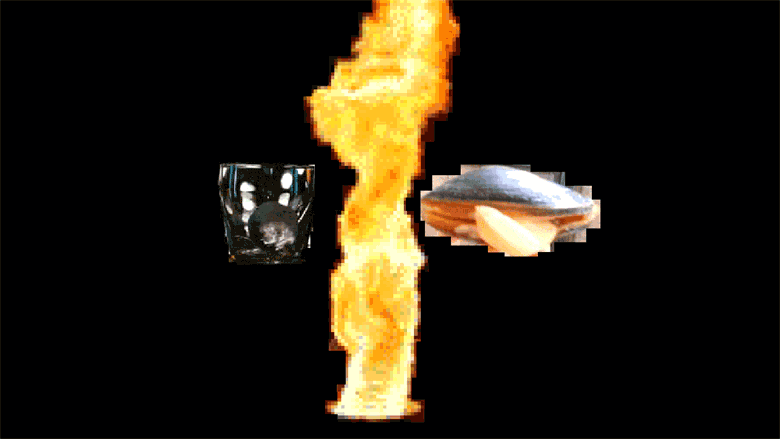A physical extension of Decoy Magazine’s ongoing series of digital art commissions, Bcc:, The Channelers showcases six artists who employ everyday digital materials and platforms such as Instagram, animated GIFs, YouTube videos, memes, banner ads, and online archives as channels for artistic expression. This exhibition involves the physical presentation of a compilation of digital artworks, which come in the form of a .jpg, .gif, .mp4, .mp3 or any other digital file small enough to be transferred swiftly and broadly. Taking Hito Steyerl’s 2009 essay In Defense of the Poor Image as a departure point, this exhibition explores the importance of file size, resolution, and self-determined distribution channels across post-colonial, feminist, queer, and anti-censorship contexts.
I: False Impressions of Actualizing the Marxist Dream
Back in 2009, Hito Steyerl’s essay, “In Defense of the Poor Image,” championed the low-resolution, degraded image. She saw the “poor image”—one that has been digitally compressed, uploaded, downloaded, reedited, remixed—as critical for confronting existing capitalist operations inherent in high-tech culture, and “the cult of mostly male genius” in the art world.1Steyerl emphasized the collaborative nature of new media as a response to the private monopolization, and state control of, mass media. Everyday users appropriate digital and networked media for their own ends—street journalism, piracy, online platform circulation—and it is this maintenance by human labour that harbours political and artistic alliances on a global scale. However, as Steyerl also underlines, the romanticizing of poor images and their patterns of circulation can too be incorporated into profit-driven media industry systems, and state regulations (surveillance, censorship, data-mining).
It is crucial here to acknowledge the racial and gendered knowing that shaped the very development of digital technology. Computational technologies have been historically rooted in military and corporate interests since World War II, accompanied by the dominance of white-western-males as leading figures in the technology industry. The fact that larger political and economic interests developed those technologies paradoxically challenges the determinist understanding of media, leaving a margin of contingency for those technologies to be invested with new values and purposes. The question comes forward: How can we mobilize contemporary media, so that they transform rather than intensify the existing relations of class, race, and gender?
Like the social imaginary of democracy as a form of participatory politics, networked media is believed to be a platform for free expression, a flagship for equal participation. At the intersection of being a producer and consumer of media, the user comes to the foreground as an active agent constituted by and reliant on online corporate media platforms. Literary and Performance Studies scholar, Diana Taylor describes the myth of user (the ‘YOU’ in YouTube) as the impression of actualizing a 21st century-version of the Marxist dream—the illusion of controlling the means of production, distribution, and access to information; where in truth, user relationships are only a shift toward a permanent dynamic exchange that is vulnerable to commodification and colonization at any stage.2Taylor says:
The ‘new’ YOU is a global citizen. . . . We’re all post-racism, post-sexism, the images suggest. . . .But these are not the bodies of the repertoire. This YOU actually exists not in relationship but as separate form.3
Networked media is assumed to evoke participatory politics, but often ends up only intensifying already exclusionary modes of representation and access. Despite the increased participation in numbers, who owns the operating systems through which all the self-produced content is shared? Mechanisms of standardization and discriminative rationale embedded within algorithms disrupt the egalitarian potential of networked media, where individuals and collectives are reduced to attributes and calculations via global markets and the technology industry. As media theorist Alexander R. Galloway puts it, the founding principle of network is not freedom, but control.4 Analysis of network protocols5shows that the Internet is a highly regulated bureaucracy, shaped by corporate interests, more than a venue for freely exchanged information.
In order to understand the contemporary struggle of the user, look to the ideological restructuring that took place during the transition to a neoliberal economy in 1980s, which heavily relied on globalized free markets, private property rights, and the growth of service economies reliant on flexible labour. Finally, this period witnessed the repression of large class-conflict based movements, which were replaced by the rise of fragmented identity-based struggles. Such a historical moment was accompanied by a utopian thinking of art’s relationship to the social that would not only put pressure on the modes of artistic production under capitalism, but also recreate numbed social bonds.6In this sense, our current neoliberal economy is built upon a renewed affirmation of collectivity, which takes the form of mobility, network, democracy, and affective/cognitive labour. In her renowned 2012 book Artificial Hells: Participatory Art and the Politics of Spectatorship, art historian Claire Bishop warned against seeing intersubjective relations as an end in themselves inartistic practices, and advocated, rather, for using them as a means to explore more complex issues of class, inequality, and political engagement.7In other words, participatory or user-based art should pay attention to the gaping trap of reproducing the neoliberal capitalist values that it stands against.
Since the explosion of net art and hacker culture in the 1990s, some have celebrated Internet’s capacity for collective action, where others have criticized the increased speed of information, and heightened surveillance. Poor images are not the ultimate solution to the capitalist image, but do succeed in enabling collaborative-creative practices, rendering underlying technical infrastructures and human labour more visible, and opening up the possibility for self-organization. It is within this ever-updating dynamic that The Channelers sets itself: between challenging and perpetuating capitalism.
Narratives of progress and innovation, concretized in the form of constantly updated, corporately-operated media platforms, have put the materiality of medium itself into question. Early new media scholars argued digital media to be immaterial and disembodied, due to consisting of only binary digits and algorithms. Friedrich Kittler, one of the pioneer digital media theorists, even argued the concept of medium itself to be obsolete due to the standardization of digital conversion. He claimed that all media forms become one when converted to digital, so the very concept of the medium itself could be erased.8This concept of the obsolescence of medium has lead to a strategic wave of ‘media convergence,’ which hopes to minimize the differences between individual media in order to expand cross-platform promotion and selling practices.
It is within this ever-updating dynamic that The Channelers sets itself: between challenging and perpetuating capitalism.
Literary scholar and media theorist N. Katherine Hayles, in her critical analysis of the history of cybernetics, showed that the ideology of immateriality and disembodiment has shaped the conceptual development of information technologies from the beginning. She also asserts that information is a social construct that could have been given different definitions.9The ever-changing concept of information is subordinate to the technical demands of communication systems. Contemplating the limits of information in relationship to the ideas of Claude Elwood Shannon—the founder of electronic communications age starting in 1940s, also considered “the father of information theory”—media theorist Tiziana Terranova writes:
Shannon’s definition of information is dependent on the problematic of the accurate reproduction of a weak impulse or signal across a range of different media channels (telegraphy, telephony, radio, television, computing). Information is thus described through a mathematical function that could be used to maximize the transmission of a signal through a channel. . . . In this sense, the signal is always identified in relation to what threatens to corrupt and distort it, that is noise.10
The minimization of divergence—noise—and the containment of error have become imperatives for not only computational systems, but also for the cultural politics that have accompanied the information age, whether in the form of increasingly specialized managerial systems at workplaces, or racially structured and segregation-based urban planning.11
Wendy Hui Kyong Chun, media scholar and author of Programmed Visions: Software and Memory (2011) and Updating to Remain the Same: Habitual New Media (2016), has also criticized the fetishization of software as the invisible but ultimate source of everything, a pipe dream that overshadows the hardware-based nature of information and human labour from code-writers to factory workers.12Information technologies rely on, but simultaneously obscure, inequality in material infrastructures, and the exploitation of human labour and natural resources. For Chun, software has become a metaphor for mind, biology, and economy—from genetics to the invisible hand of the market.13Information needs to be tied to larger trends in industry, labour, and the social imaginary that contemporary media technologies have developed, and which they serve to reproduce.
Media theorist and curator, Laura U. Marks, says the myth of immateriality, and expectations for media convergence simply fail in poor parts of the world, given inadequate electrical grids and uneven Internet access.14These are the places where the material realities of new media can be observed more fully and urgently; when the functioning of digital media is disrupted, more is revealed of its underlying mechanisms, and more importantly, it proves how errors and disruptions are operational to its functioning rather than mere exceptions. In this sense, film and media theorist, Sean Cubitt defines glitch15—Steyerl’s poor image—as the unconscious of new media, where repressed labour, material dependencies, and colonial legacies are allowed to come to the surface.16In addition, Cubitt’s glitch is not only a tactical revolt of matter, labour, or the unconscious, but also intervenes in the production of signification.17Many artists abandon the search for a sharp image, but look at the conditions that cause poor resolution in the first place and, “[w]hat they find often proves to be a keen metaphor for historical consciousness; what they create constitutes an act of historical consciousness.”18
When the functioning of digital media is disrupted, more is revealed of its underlying mechanisms, and more importantly, it proves how errors and disruptions are operational to its functioning rather than mere exceptions.
As digital and networked media open up to newer aesthetic forms and archival practices, artists are interested in the question of what the images do (or can’t do), as much as they pursue the question of what the images are conditioned by. Rather than essentializing any medium or platform, artists are interested in generating alternative encounters from a critical yet creative perspective. Multimedia platforms can provide the venue for artistic manipulations through which the artists do not only mourn the loss of previous media, but also unsettle the existing mechanisms of commodification and precarious labour, codes of racist and sexist thinking, and dominant values of the art world. In this sense, The Channelers is an investigation of the potentials and limits of using online platforms for the production and distribution of artworks, which are further complicated by being brought into established settings of the art world.
II: Pleasure in the Confusion of Boundaries and Responsibility in Their Construction
Artists, curators, and museum/gallery teams build the walls to hide ugly computers and assign crew to the ongoing maintenance of the hardware. More importantly, as ever-faster computers, updated software, and higher resolution displays are released on the market at short intervals, exhibitors are the first to witness the failures of media convergence, and the frustrations of cross-format preservation and exhibition. Media theorist and curator, Christiane Paul, emphasizes that more than any medium for art, the digital is embedded in various layers of commercial systems and technological industry.19Following Tiziana Terranova’s understanding of immateriality as “links between materialities,” Paul encourages us to look at network capabilities for art against the background of the tensions and connections between the material and the immaterial. Artistic production oscillates between the openness of networked systems and the restrictions imposed by protocols and the technology industry.20
It is on cross-platform tensions that digital art thrives, however, through complex collaborations between artists, programmers, designers, and scientists, upending existing embedded systems of authorship, copyright, and value. It is also through cross-platform tensions that new media can embrace a tone of institutional critique, drawing upon a lineage of dematerialized artistic practices that attempt to function outside art institutions and capitalist modes of production. The Dada movement of the early 20th century, the Fluxus and conceptual art movements of the 1960s, and participatory and net art of the 1990s—all continue to catalyze new like-minded projects.
The artists confront themselves, and what it means to use digital and networked media for producing and sharing art works, and the qualities of these media transform their own artistic practices.
The Channelers emerged from an ongoing project called the Bcc: Digital Art Subscription, developed by the arts publication Decoy Magazine, which releases newly commissioned digital artworks via email exclusively to subscribers at $3 per month. The works are released only once, don’t get presented anywhere else for one year, and the majority of the monthly fees go directly to the artists. While a simple transaction, Bcc: is an investigation of alternative forms of artistic production and distribution, which is also realistic about the limits and capacities of networked media. Receiving an artwork via email subscription conforms to the patterns of the contemporary media industry, but the project also reutilizes a mailing list to reach beyond the boundaries of travel bans, censorship, and art institutions. In return, the curators take care of artists’ rights and fair pay, whose labour is usually exploited and kept precarious by flexible labour conditions. Such a circulation of art works and money offers an alternative for existing systems of distribution that either exist within copyright regulations (bringing more private monopolization of art and knowledge), or fail to acknowledge and pay for artists’ creative work.
What is remarkable about Bcc: and The Channelers is that the curators and artists see new media not only as a set of practical problems, but also as a chance to expose the limits of, and transform the existing systems of the art world and media industry. The privileged position of the artist, their knowledge of visual culture and previous media, and motivation for experimenting with the medium-specific qualities of new media, comes into question. The artists confront themselves, and what it means to use digital and networked media for producing and sharing art works, and the qualities of these media transform their own artistic practices. The Channelers offers a perspective, which can be described in feminist science and technology scholar Donna Haraway’s terms, “for pleasure in the confusion of boundaries and for responsibility in their construction.”21In this case, artists are enabled to hold onto aesthetic journeys and political commitments, while exploring alternative systems for the distribution of value.
The Channelers, curated by Lauren Marsden & Maria Fedorova of Decoy Magazine, will be exhibited at EMMEDIA Gallery & Production Society until March 3, 2018.
Lauren Marsden is an artist, teacher, and editor based in Vancouver, BC. Her own artistic practice is focused on GIF-making, videomaking, and photographic images that study the nature of performance. She teaches video and media arts at the University of Victoria, critical arts writing at Simon Fraser University, and is the founding editor of Decoy Magazine, where she also oversees a number of curatorial projects, including the Bcc: Digital Art Subscription.






